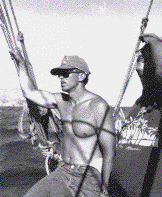 |
|
Voyaging into Polynesia's Past Ben Finney Culturally, the 1976 voyage was also a great success. Hawaiians and Tahitians regarded the voyage as tangible proof of the nautical abilities of their ancestors, and saw the canoe as a symbol of their heritage as an exploring, pioneering people. In Hawai'i, the voyage is credited with helping to spark a cultural renaissance, while in Tahiti, the dramatic arrival of Hokule'a at a time when tough negotiations with French colonial authorities for increased local autonomy were in progress, raised the flagging morale of the French Polynesians and helped them achieve their aims. Later, they even adopted a double-canoe motif inspired by Hokule'a as their symbol of nationhood, placing it in the center of their new flag. However, despite the fact that the canoe had been designed, captained and largely crewed by Hawaiians, many Hawaiians felt that a crucial element had been missing in the venture: a Hawaiian had not navigated the canoe along the seaway between Hawai'i and Tahiti as their ancestors had once done.
Like traditional navigators, Nainoa relies primarily on the stars for orientation and course setting. The points along the horizon where key stars rise in the east and set in the west provide him with accurate bearings. He has memorized these stars, as well as others that rise and set in the same location so as to be able to keep oriented when the key stars have risen too high in the sky to give an accurate bearing, or are below the horizon. Nainoa has learned how to constantly keep track of the direction of the dominant ocean swells, periodically calibrating his observations against the star field so that when clouds totally obscure the heavens he can keep the canoe on the right course by reference to the swells. When the sun is low on the horizon during the early morning and the late afternoon he uses it for orientation and steering, although since the sun is constantly shifting its rising and setting points, each dawn Nainoa must check the sun's position with reference to the fading star field. When the sun has risen too high in the sky to yield a reliable bearing, Nainoa keeps the canoe oriented with reference to the swell pattern. Based on the teaching of Mau Piailug, Nainoa has developed a system of dead reckoning by which he uses his estimates of the distance and course sailed to mentally track the canoe in terms of the changing distances and bearings from his departure point and to his destination, and in terms of how far the canoe may have strayed to one side or other of the planned course line. Nainoa also observes Polaris, the Southern Cross and other stars and estimates (with nothing more than his outstretched hand as a guide) their angular elevation above the horizon to get an idea of the latitude of the canoe, which he then mentally integrates with his dead reckoning to further refine where he thinks the canoe is at any one time. To detect when the canoe is getting close to land before it can actually be seen, Nainoa relies primarily upon sighting of "landfinding birds"--those species of terns and bookies which sleep on land but fly out to sea each day to fish. When, for example, one sees a group of white fairy terns fishing together, this can mean that land is no farther than 20 or 30 miles--particularly during nesting season when adults must return periodically to land to feed their chicks. In the summer of 1980 Nainoa successfully applied his non-instrument navigation system to guide Hokule'a from Hawai'i to Tahiti and return. [The canoe left Hilo on March 15, 1980 and arrived in Tahiti 33 days later on April 17, 1980. The canoe sailed back to Hawai`i on May 13, 1980, and arrived 24 days later on June 6, 1980.] In replicating Mau's feat of navigating the canoe to Tahiti, and then guiding it back to Hawai'i, Nainoa was able to validate and extend the results of the 1976 navigational experiment. That he was the first Polynesian to accomplish this feat since the legendary voyages of the 12th and 13th centuries A.D. was not at all lost on the Hawaiians and the Tahitians. Not only did Nainoa's accomplishment remind them that their ancestors had been capable of the tremendous intellectual discipline required by non-instrument navigation, but he showed them how a modern Polynesian, cut adrift from his cultural roots by the events and developments of the last two centuries, could re-learn this ancestral art and apply it to sail over thousands of miles of open ocean. (For more on the 1980 voyage, see Ben Finney, Bernard J. Kilonsky, Stephen Somsen, Edward D. Stroup, 1986. "Re-Leaming a Vanishing Art" in the Journal of the Polynesian Society. 95:41-90.) This account was originally published in "Voyaging into Polynesia's Past" in From Sea to Space (Palmerston North: Massey University, 1992. 5-65). Other parts of this article are online: The Founding of the Polynesian Voyaging Society; Hawai'i to Tahiti and Return: 1976; Hawai'i to Tahiti and Return: 1980; Voyage of Rediscovery: 1985-87. See "Sin at Awarua" for Finney's account of the 1995 Voyage to Ra'iatea and Nukuhiva. |
